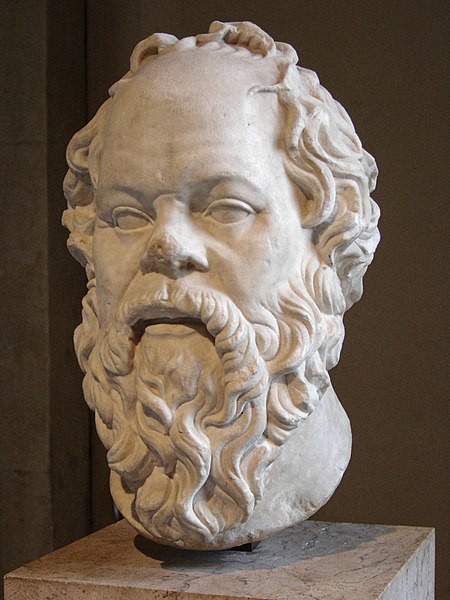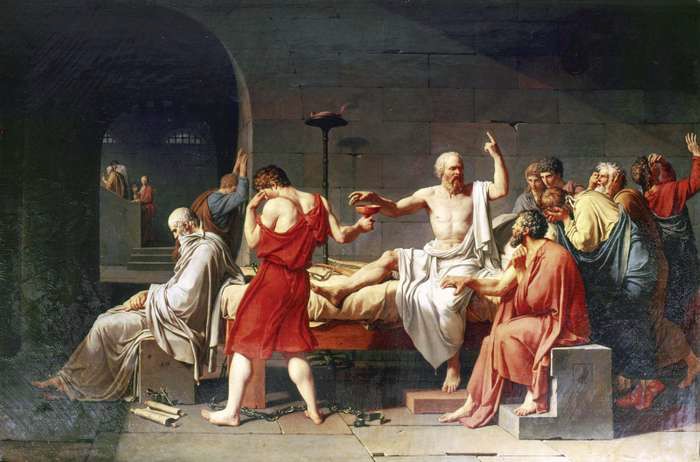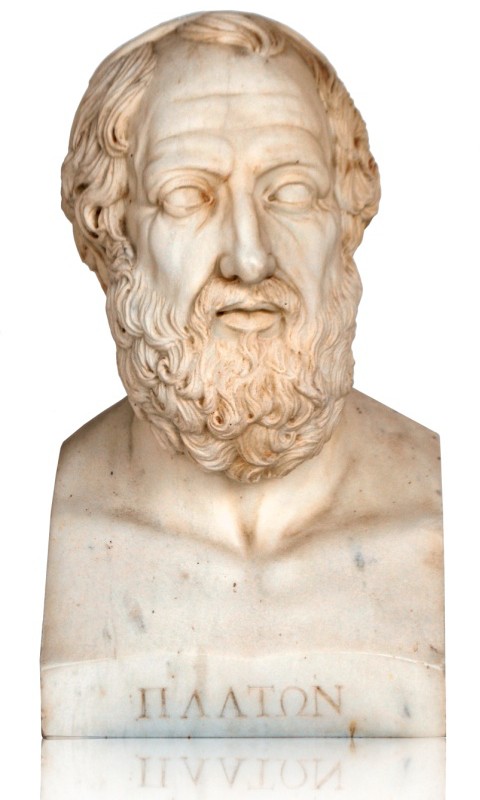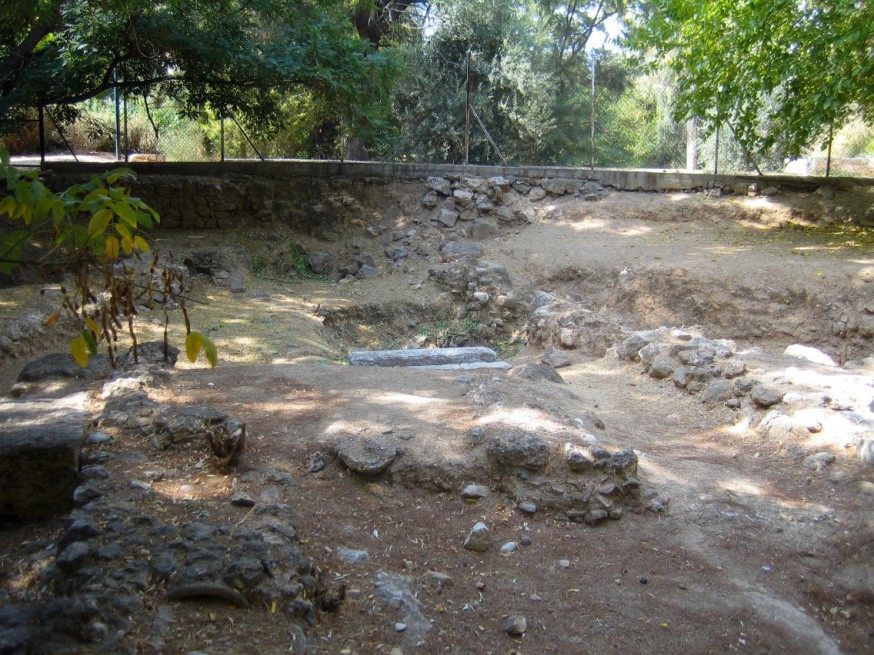4.15 GREEK PHILOSOPHY
Socrates and the Apology
Socrates, born in Athens in the 5th century BCE, marks a watershed in ancient Greek philosophy. Athens was a center of learning, with sophists and philosophers traveling from across Greece to teach rhetoric, astronomy, cosmology, geometry, and the like. Rhetoric is the art of effective or persuasive speaking or writing, especially the use of figures of speech and other compositional techniques.

The great statesman Pericles was closely associated with these new teachings, however, and his political opponents struck at him by taking advantage of a conservative reaction against the philosophers. It became a crime to investigate issues above the heavens or below the earth because they were considered impious. While other philosophers, such as Anaxagoras, were forced to flee Athens, Socrates was the only documented individual charged under this law, convicted, and sentenced to death in 399 BCE. In the version of his defense speech presented by Plato, he claims that the envy others experience on account of his being a philosopher is what will lead to his conviction.
Many conversations involving Socrates (as recounted by Plato and Xenophon) end without having reached a firm conclusion, a style known as aporia. Socrates is said to have pursued this probing question-and-answer style of examination on a number of topics, usually attempting to arrive at a defensible and attractive definition of a virtue. While Socrates’ recorded conversations rarely provide a definitive answer to the question under examination, several maxims or paradoxes for which he has become known recur. Socrates taught that no one desires what is bad, and so if anyone does something that truly is bad, it must be unwillingly or out of ignorance; consequently, all virtue is knowledge. He frequently remarks on his own ignorance, claiming that he does not know what courage is, for example. Plato presents Socrates as distinguishing himself from the common run of mankind by the fact that, while they know nothing noble and good, they do not know that they do not know, whereas Socrates knows and acknowledges that he knows nothing noble and good.
Socrates was morally, intellectually, and politically at odds with many of his fellow Athenians. When he was on trial, he used his method of elenchos, a dialectic method of inquiry that resembles the scientific method, to demonstrate to the jurors that their moral values are wrong-headed. He tells them they are concerned with their families, careers, and political responsibilities when they ought to be worried about the “welfare of their souls.” Socrates’ assertion that the gods had singled him out as a divine emissary seemed to provoke irritation, if not outright ridicule. Socrates also questioned the Sophistic doctrine that arete (virtue) can be taught. He liked to observe that successful fathers, such as the prominent military general Pericles, did not produce sons of their own quality. Socrates argued that moral excellence was more a matter of divine bequest than parental nurture.
Socrates was unable to write. He was known for wandering the city barefooted and asking uncomfortable questions as a method of inquiry into the truth. Because he was not literate, one must turn to the writings of others, such as Socrates’ most famous pupil, Plato, in order to understand him. The Apology, written by Plato is one of the few writings by Plato that can be verified by the words of other writers. As such, The Apology is probably a fairly accurate rendering of Socrates’ trial.

Image 4.145 shows one of the places where Socrates was probably held during his trial and subsequent execution. Following his conviction of having corrupted the youth and looking into things above and below the earth, he drank hemlock, a poison that provides an extremely painful end. According to Plato’s Apology, it is in his trial that Socrates coined the now famous idealistic phrase, “The unexamined life is not worth living.”(Plato’s Apology)

Socrates goes on to demonstrate his humanism in his attention to serving the populace and his belief in reason as the path to truth, in his story about the oracle that deemed him the wisest man. He claimed that he was only wiser because he knew what he did not know. It would seem that he was correct in his assessment of why people did not all like him. Philosophers were associated with unpopular ideas such as sophism, where people taught persuasive speech for money. His constant questioning, which he associated with the need to find truth, and as such with his position as a philosopher, often alienated those who did not really wish to see the truth. Although many did indeed dislike him due to his intellectual pursuits, and although he ended his life in prison, his ideas continue to influence the world, over two thousand years later.
PLATO AND ARISTOTLE: DISAGREEMENTS ON PHILOSOPHY
Plato was an Athenian of the generation after Socrates. Ancient tradition ascribes 36 dialogues and 13 letters to him, although of these only 24 of the dialogues are now universally recognized as authentic. Most modern scholars believe that Plato wrote at least 28 dialogues, and two of the letters. Plato’s dialogues feature Socrates, although not always as the leader of the conversation. Along with Xenophon, Plato is the primary source of information about Socrates’ life and beliefs, and it is not always easy to distinguish between the two. Plato’s work generally supports the values of the Classical Greeks.
Much of what is known about Plato’s doctrines is derived from what Aristotle reports about them, and many of Plato’s political doctrines are derived from Aristotle’s works: The Republic, the Laws, and the Statesman. The Republic contains the suggestion that there will not be justice in cities unless they are ruled by philosopher kings; those responsible for enforcing the laws are compelled to hold their women, children, and property in common; and the individual is taught to pursue the common good through noble lies. The Republic determines that such a city is likely impossible, however, and generally assumes that philosophers would refuse to rule if the citizenry asked them to, and moreover, the citizenry would refuse to compel philosophers to rule in the first place.

“Platonism” is a term coined by scholars to refer to the intellectual consequences of denying, as Plato’s Socrates often does, the reality of the material world. In several dialogues, most notably The Republic, Socrates inverts the common man’s intuition about what is knowable and what is real. While most people take the objects of their senses to be real if anything is, Socrates is contemptuous of people who think that something has to be graspable in the hands to be real. Socrates’ idea that reality is unavailable to those who use their senses is what puts him at odds with the common man and with common sense.
Plato says that he who sees with his eyes is blind, and this idea is most famously captured in his allegory of the cave, a paradoxical analogy wherein Plato argues that the invisible world is the most intelligible and that the visible world is the least knowable and most obscure. In the allegory, Plato describes a gathering of people who have lived chained to the wall of a cave facing a blank wall. The people watch shadows projected on the wall from the fire burning behind them, and the people begin to name and describe the shadows, which are the closest images they have to reality. Plato then explains that a philosopher is like a prisoner released from that cave, and who comes to understand that the shadows on the wall are not reality. This is clear evidence that Plato and Socrates were idealists, reaching beyond this reality for truth.
Plato also embraced rationalism as is seen in the fact that he felt that the philosophers, masters of reason, were best suited to rule. He was also a humanist but never escaped his own elitism, as is evidenced by his suggestion that the average person was not fit to rule themselves. Plato embraced Rationalism, Humanism and Idealism and he believed that knowledge was the highest good.
ARISTOTLE:
Aristotle moved to Athens from his native Stageira in 367 BCE, and began to study philosophy, and perhaps even rhetoric under Isocrates. He eventually enrolled at Plato’s Academy. He left Athens approximately twenty years later to study botany and zoology, became a tutor of Alexander the Great, and ultimately returned to Athens a decade later to establish his own school, the Lyceum. Like, Plato before him, Aristotle’s ideas reflected the world in which he lived. He is the founder of the Peripatetic School of philosophy, which aims to glean facts from experiences and explore the “why” in all things. In other words, he advocates learning by induction.

At least 29 of Aristotle’s treatises have survived, known as the corpus Aristotelicum. They address a variety of subjects including logic, physics, optics, metaphysics, ethics, rhetoric, politics, poetry, botany, and zoology. Aristotle is often portrayed as disagreeing with his teacher, Plato. He criticizes the regimes described in Plato’s Republic and Laws, and refers to the theory of forms as “empty words and poetic metaphors.”
Aristotle’s ideas reflected the changing values of post war Athens. He preferred utilizing empirical observation and practical concerns in his works. Aristotle did not consider virtue to be simple knowledge as Plato did, but founded in one’s nature, habit, and reason. Virtue was gained by acting in accordance with nature and moderation. This, according to the philosopher, would help a person achieve the highest good, which he considered to be happiness. Aristotle’s ideas focused less on the ideal and more on individual pursuit and empirical evidence. As such, he looked at the world around him, and the world of the past, to find truth.

Attributions:
Boundless World History 1. Ancient Civilizations to Enlightenment/ “Ancient Greece and the Hellenistic World” iv
Modified by T. Kate Pagel, PhD for “Greek Philosophy.” Humanities: New Meaning From the Ancient World. Colorado Springs, CO: Pikes Peak Community College, 2019. CC BY-NC 4.0 License.
Boundless World History 1. Ancient Civilizations to Enlightenment/ “Ancient Greece and the Hellenistic World”3 Modified by T. Kate Pagel PhD for “ Greek Philosophy” Humanities: New Meaning From the Ancient World.
References:
1. Photo by Eric Gaba, CC BY-NC-2.5. https://commons.wikimedia.org/wiki/File:Socrates_Louvre.jpg
2. Photo by Nikolaos Douralas is licensed under CC BY-NC 2.0, https://search.creativecommons.org/photos/1cbd0ac6-9483-4a12-9e02- c5ed8c887739
3. Photo by Rodney, CC BY 2.0, https://commons.wikimedia.org/wiki/File:Death_of_Socrates_(1787)_(1252779378).jpg
4. Boundless World History 1: Ancient civilizations-Enlightenment/ Ancient Greece and the Hellenistic World. http://oer2go.org/mods/en- boundless/www.boundless.com/world-history/textbooks/boundless-world-history-i- ancient-civilizations-enlightenment-textbook/ancient- greece-and-the-hellenistic-world-2/culture-in-classical-greece- 18/classical-greek-philosophy-86-13168/index.html
5. Photo by Jean Housen, CC BY-SA 4.0, https://upload.wikimedia.org/wikipedia/commons/a/a4/20140416_corfu232-cropped-bg.jpg
6. Photo by Jastrow, Public domain, https://commons.wikimedia.org/wiki/File:Aristotle_Altemps_Inv8575.jpg
7. Photo by Tomisti, CC BY-SA 3.0, https://commons.wikimedia.org/wiki/File:Athens_Plato_Academy_Archaeological_Site_5.jpg

